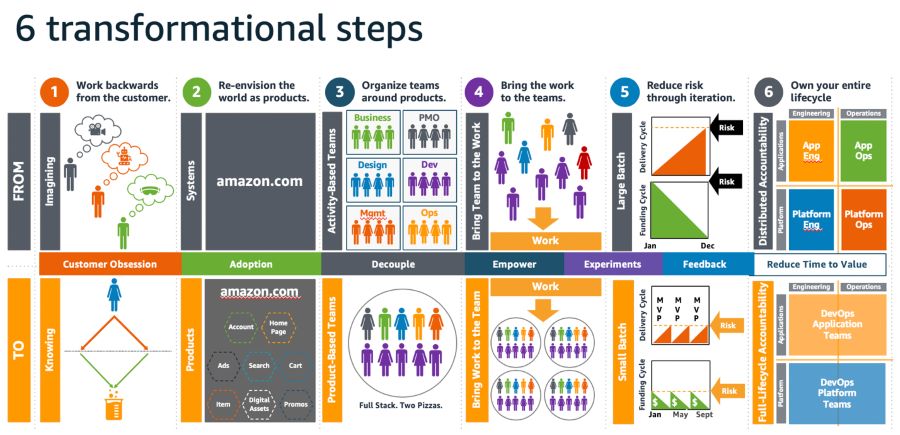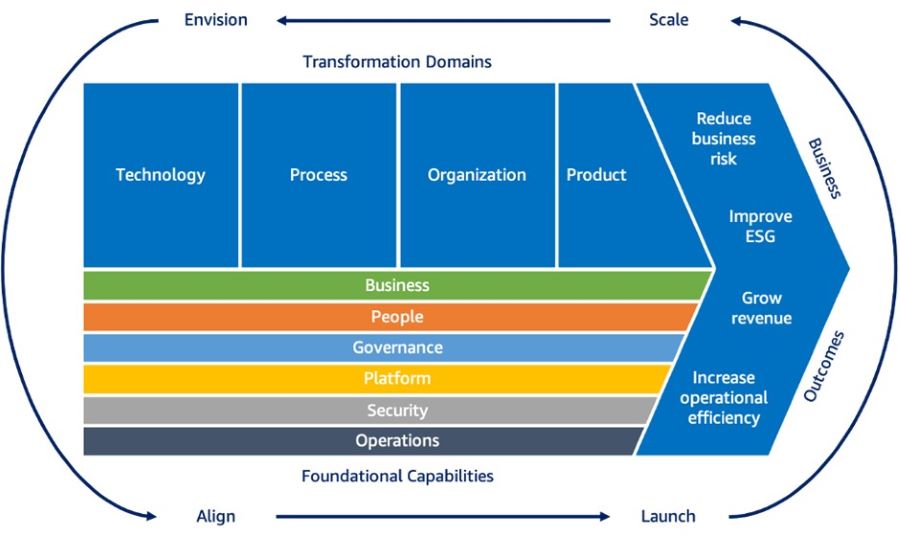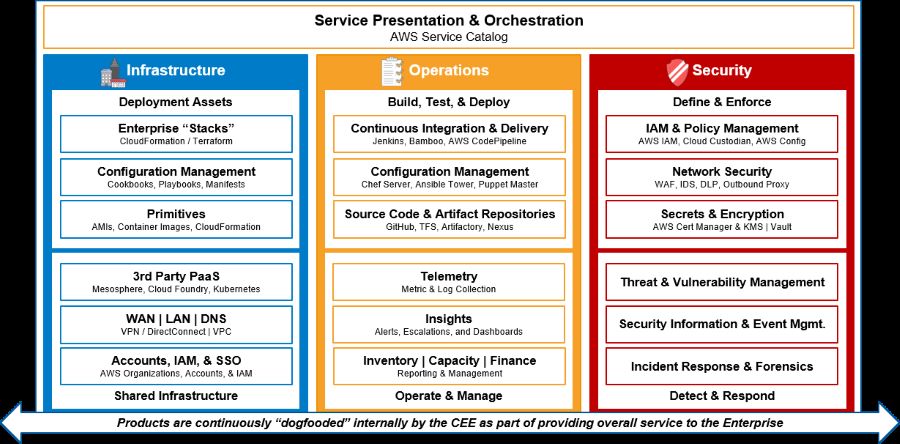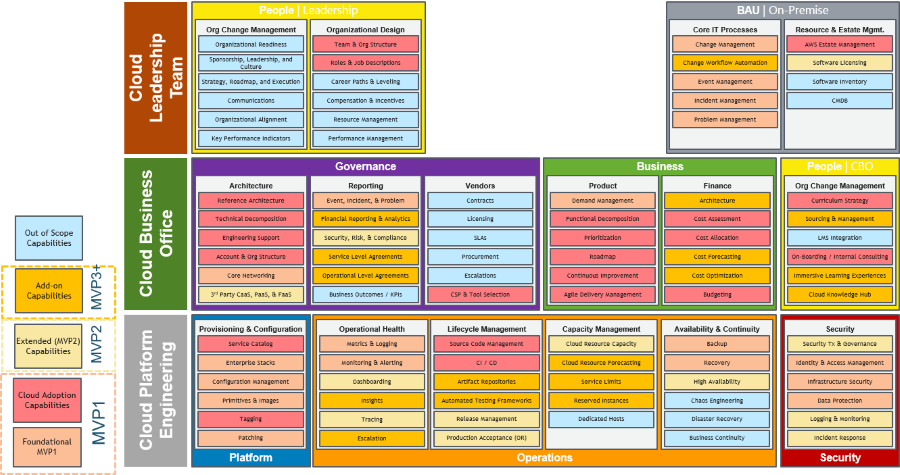|
This article outlines the key principles for developing a successful cloud operating model (COM) that enables organizations to efficiently and securely adopt cloud solutions and drive business outcomes. Establishing an Effective COM Establishing a well-designed COM is crucial for the successful adoption of cloud technology within an organization. The impact of cloud adoption extends beyond just the IT department and has significant implications for the organizational culture and IT delivery structures. It is essential to understand these implications and the organization's readiness for change when building a successful COM. To facilitate this transformation, organizations need to have a sufficient number of individuals with experience in utilizing cloud services, such as Amazon Web Services (AWS), who can effectively implement and manage the underlying cloud platform using a product-centric approach. Moving Beyond Traditional ApproachesMany organizations initially approach cloud adoption as an additional layer of technology within their existing operating model and infrastructure. While this approach may lead to cost savings and value through reduced infrastructure expenses compared to traditional on-premises solutions, it also presents challenges. One of the main concerns is that organizations may struggle to keep up with the pace of new business initiatives due to the complexity introduced by adding another technology layer. It often takes a significant event or issue to prompt IT leaders to take action and establish a dedicated Cloud team or a Center of Excellence (COE). AWS refer to this capability as a Cloud Enablement Engine (CEE). A CEE encompasses a combination of technology and business resources aimed at guiding the organization through its cloud adoption journey, addressing the most critical needs of the business as a whole, not just the IT department. This article discusses essential elements for establishing a successful cloud adoption capability and outlines mechanisms for accelerating the process before major events or issues occur. Additionally, it demonstrates how the AWS Domain model can help align the operating model with the most critical business needs. Prerequisites for Success To ensure the success of cloud adoption, the CEE should align with the organization's primary business objectives and outcomes. This ensures that the evaluation of cloud adoption success is measured in terms of the business benefits achieved and establishes the foundation for the operating model and task prioritization. An important prerequisite for success is obtaining endorsement from organizational leaders and securing executive sponsorship in the form of a Cloud Leadership Team. Successful cloud adopters challenge the existing norms within their organizations. Without this sponsorship and support, CEEs may face obstacles and encounter delays. In large organizations with multiple business units, it may be necessary to consider additional or alternative federated approaches, such as establishing a Community of Practice, rather than relying solely on a centralized team. Target Business Outcomes and Value When it comes to building and establishing a Cloud Operating Model (COM), the desired outcomes are not strictly defined like in some technical domains. My experience in working with successful cloud technology leaders, such as CIOs and CTOs, has shown that they prioritize the creation of a value-generating Cloud Enablement Engine (CEE) before encountering failures and firefighting scenarios. Here are some examples of value generation observed among AWS adopters:
The Focus on Technology and Reactive ResponsesUnfortunately, many IT leaders tend to focus solely on the technical aspects of cloud until issues arise, forcing them to take action and adopt different approaches. The most common issues that prompt such reactions are:
Enabling Innovation and Value with a Successful COM A successful COM empowers organizations to operate applications in the cloud with increased speed, innovation, and business value, all while maintaining reliability and security. A key aspect of leading COM approaches is the adoption of a product-based mindset for the cloud platform. By embracing this approach, each team takes ownership and responsibility for operational excellence, actively maintaining self-healing systems that quickly recover from failures through integrated detection and remediation mechanisms. Additionally, platform optimization can be achieved by measuring known application baselines and testing them using chaos engineering (failure injection) and game days (interactive team-based learning exercises). Cultural Shift and Automation Focus Implementing these recommendations often requires a cultural shift in how organizations design, deploy, and operate their cloud platforms. It involves prioritizing automation and establishing repeatable processes that enhance efficiency and reliability over time. Product-Based Delivery of CloudThe most successful cloud customers approach their cloud initiatives with a product mindset, prioritizing excellent customer experiences. In this context, a product is defined by its ability to perform a limited set of tasks exceptionally well, with clearly defined inputs and outputs, serving multiple customers and continuously evolving to meet their needs. An example of this approach can be seen in Amazon.com, where multiple product teams manage different aspects of the customer website. Defining products is crucial as it establishes the relationship between customers (consumers), products, and the teams responsible for creating them (suppliers). These interdependencies highlight the dual role of product teams as both consumers and suppliers, necessitating a higher level of ownership, accountability, and scrutiny to ensure the delivery of high-quality products and services. Benefits of a Product-Based Approach When companies fail to define and operate their systems as products, they often experience foundational failures that could have been mitigated through cross-product accountability. By assigning end-to-end ownership and accountability to each product team, encompassing business and operational aspects, they become fully responsible for all aspects of their services. Even shared service providers act as product owners, offering services that other product teams can choose to use. It's important to note that the demand for each product should be assessed, and those that are not useful to the business should be deprioritized. The primary outcome is that each product team maintains accountability and doesn't relinquish responsibility to other product suppliers. Building Customer Empathy and Trust By taking full ownership of a product's operation and considering the end customer's perspective, companies cultivate empathy and understanding. As product owners establish contracts with other product owners, a supplier-consumer relationship is formed, fostering trust. Empowering product teams to make decisions about problem-solving approaches and choosing other products they collaborate with ensures full accountability for the product's performance and customer perception. Key Concepts for a Product Mindset To foster a functional product mindset and minimize future events that impact customers, four foundational concepts are crucial:
Summary of ActivitiesSeveral key activities can facilitate and accelerate cloud adoption and the delivery of business outcomes. In enterprises, competing priorities often exist within their cloud strategy. Failure to transform operating models can result in a phenomenon known as the "great stall," where adoption momentum slows or halts. Establishing a cloud delivery and governance function, often referred to as a Cloud Center of Excellence (CCoE) or Cloud Enablement Engine (CEE), has proven to be a significant factor in avoiding this effect. This document outlines six steps that companies should follow to build a successful CEE:
Figure 1: Six transformational steps for building a cloud operating model Step 1: Work Backwards from the CustomerIn order to build successful Cloud Operating Models (COMs), it is crucial to deliver innovative, cost-effective, reliable, and secure solutions that accelerate business outcomes for organizational business units. Many companies often make guesses or assumptions about what their customers want, relying on imagination or hunches. However, this approach increases the likelihood of being wrong. To truly be customer-centric or customer-obsessed, teams need to move from imagining to knowing. This involves dedicating time to understanding customers, identifying their delights and pain points. Data should be leveraged to prove a deep understanding of customers and their needs. Then, the focus should be on finding the best solutions to address their pain points, gradually narrowing down the options until the simplest and most effective solution emerges. Balancing Core COM Capabilities A Cloud Enablement Engine (CEE) should prioritize core COM capabilities while striking a balance between innovation and security. Reliability is essential, but it's important for organizations to operate and invest within their budget constraints. AWS helps customers achieve this balance by aligning the delivery to their Cloud Adoption Framework (CAF), which draws from the best practices of cloud transformations accumulated over many years. Figure 2: The AWS Cloud Adoption Framework - Capabilities and Domains Connecting Business Goals to Business and Technology Enablers Many cloud adoptions start from a highly technical perspective. By utilizing a combination of the working backwards and envisioning processes, AWS helps establish a foundation for a cloud strategy and operating model that consistently delivers measurable value to organizations. The envisioning process establishes a connection between business goals and outcomes, identifies key metrics, and enables prioritization of cloud initiatives. The working backwards process translates this into a customer-facing narrative, allowing for validation of the vision with key stakeholders before development commences. The outcome is a clear linkage between enabling technologies, cloud initiatives, and stakeholder approval, focusing on the most critical business outcomes and success measures. Ideally, these initiatives should be developed iteratively and in collaboration with key stakeholders. Aligning Stakeholders to Overcome Blockers Once a shared vision is established, it is crucial to create a backlog of tasks, using Agile terminology such as epics and stories. The AWS CAF Align phase emphasizes the identification of capability gaps across six perspectives:
This phase also highlights cross-organizational dependencies and surfaces stakeholder concerns and challenges. Building upon the output of the envisioning process, the CAF Align phase develops a collaborative and practical action plan to facilitate the kickstart of a COM that aligns with key initiatives. This approach focuses on identifying blockers and addressing concerns from six groups of stakeholders. Each perspective encompasses a set of defined capabilities that are significantly impacted by cloud adoption. Through the CAF alignment approach, customers can understand and plan for the impact of cloud on various capabilities, not just the technological challenges. This framework helps customers recognize these changes as common and well-understood while developing a prescriptive action plan to address concerns and remove barriers to cloud adoption. Step 2: Re-envision the World as ProductsIn many organizations, the systems that support their business operations are often complex and tangled, developed over time without a clear structure. Even Amazon faced this challenge in the past, with a large, Java-based ecommerce application supporting its business. To transition to a product model that enables broader adoption and reuse of functionality beyond retail, a reimagining of individual products was necessary. Here are some examples: Identifying Individual Products To facilitate the transition, it was essential to identify the individual products that would make up the new architecture. This process involved rethinking the functionalities and components that would serve as the building blocks for the future architecture. It's important to note that this is not the same as refactoring the existing architecture. Refactoring can only occur once there is clarity on the components that will constitute the future architecture. Transitioning to a Product-Focused Approach for the Cloud Platform For the cloud platform, the shift involves moving away from an alignment centered around systems and technology. Instead, the focus is on creating collections of products, services, and technologies grouped together to form a cohesive product. This product-centric approach aligns with the four-point definition highlighted earlier in this document. Here are examples of cloud products, which may include a combination of AWS and non-AWS products and services:
By organizing functionalities into distinct products, organizations can better manage and leverage their cloud platform. Each product represents a self-contained unit that can be independently developed, deployed, and maintained. This approach fosters modularity, scalability, and reusability, enabling organizations to derive maximum value from their cloud investments. It's worth emphasizing that the shift towards a product-focused approach requires a change in mindset and organizational structure. Teams need to align around products rather than systems and technologies, fostering collaboration and ownership within each product team. This shift allows for better customer-centricity, as teams can dedicate their efforts to delivering exceptional products and experiences that meet customer needs. By adopting a product-centric approach for the cloud platform, organizations can unlock the benefits of modularity, scalability, and reusability, driving innovation and delivering value to customers. Step 3: Organize the Teams around ProductsOnce a set of cloud products has been identified, the next step is to organize teams around the ownership and accountability of those products. A successful cloud operating model (COM) ensures that all components, including people, processes, and tools, are aligned to support each other effectively. As customer needs evolve over time, it is crucial to continuously evolve and meet their expectations. Clear product ownership is the key to achieving this. Formation of a Cloud Center of Excellence (CCoE) To establish effective product ownership, it is recommended to form a Cloud Center of Excellence (CCoE), consisting of two functional domains: Cloud Business Office (CBO) and Cloud Platform Engineering (CPE). The CBO focuses on aligning the CEE's products and services with the needs of enterprise customers and leadership. It takes charge of business governance and people enablement aspects of cloud adoption. Figure 3: CBO capabilities CBO Capabilities The CBO's responsibilities include:
CPE: Foundational Structure for the CBO Underpinning the CBO is Cloud Platform Engineering (CPE), which is responsible for codifying the differences between stock AWS service configurations and enterprise standards applicable within the organization. The CPE's role is to package and continuously improve the cloud platform as a set of self-service deployable products for customers and consumers. Figure 4 below, illustrates this structure. Figure 4: Cloud platform engineering capabilities Cloud Platform Engineering Capabilities The CPE teams have the following responsibilities:
By organizing teams around products and establishing clear ownership and accountability, organizations can effectively deliver cloud products and services. The CBO and CPE domains of the CEE play critical roles in aligning with customer needs, driving business outcomes, and ensuring the efficient deployment and operation of cloud solutions. Automation within the CPE further enhances resiliency, availability, and overall product quality. Step 4: Bring the Work to the TeamsInstead of building a comprehensive Cloud Enablement Engine (CEE) to support the entire business all at once, we recommend taking an incremental approach. Think big, but start small. This approach allows teams and customers to build and learn iteratively as they scale their adoption of cloud solutions. The Cloud Foundation Team The initial product team in the CEE is known as the Cloud Foundation Team. It should be cross-functional and encompass all the necessary roles and capabilities that will eventually expand into a full-fledged CEE. When staffing a product team, it is important to consider and balance four key concerns or perspectives:
Scaling the Cloud Foundation Team As cloud adoption expands, the Cloud Foundation Team must grow and scale to keep pace with the AWS customer journey. Although each customer journey is unique, successful cloud adopters often follow a pattern of subdivision and specialization. Typically, the initial CEE is divided into four product teams: one for the Cloud Business Office (CBO) and three for the Cloud Platform Engineering (CPE). In larger organizations, this subdivision and specialization process continues based on the backlog of work. Key Roles in the Cloud Foundation Team The cloud foundation team requires the following key roles:
Additional Roles in the Cloud Foundation Team Other roles that are typically added to the cloud foundation team, though they may be part-time, include:
By bringing the work to the teams and establishing the Cloud Foundation Team, organizations can effectively start their cloud journey. These teams, with their defined roles and responsibilities, provide the necessary foundation for driving successful cloud adoption and delivering business outcomes in a structured and efficient manner. Step 5: Reduce Risk through Iteration and Automation Implementing an effective operating model is an ongoing process that requires continuous improvement through measurement and testing. All product teams share the responsibility of establishing measures to ensure they deliver the expected outcomes and operate within acceptable limits. In this model, product owners are accountable for measuring not only their product's performance but also the services on which their product relies. Transparent metrics and measures provided and consumed by different product teams enable informed decision-making. Embedding Testing and Automation To maintain the functionality of the operating model when introducing new products, it is crucial to incorporate constant, automated, and standardized testing into the development process. This testing serves two important purposes:
By integrating robust testing practices and automation into the development and deployment of new products, organizations can significantly reduce risks associated with failures and ensure the smooth functioning of the operating model. Regular testing and simulation provide valuable insights that contribute to the continuous improvement and optimization of the cloud environment. Step 6: Own Your Own LifecycleThe cloud presents opportunities to address accumulated workarounds and neglected IT systems by adopting a proactive approach. However, organizations must be cautious not to fall into the trap of pursuing perfection at the expense of practicality. Successful adopters take two key actions to help ensure they own their own lifecycle and deliver meaningful benefits. First, they align the operating model delivery approach to the strategic value of the workload and second, successful COMs and CEEs establish a clear roadmap of delivering capabilities and processes that align and underpin the ability to establish production operations in an MVP and iterative approach. Operating Model Options When it comes to the operating model, it's important to acknowledge that not everyone will immediately embrace a DevOps approach. My engagements with customers have revealed three broad operating models, as shown in Figure 5 below. Figure 5: Modernizing IT Sustain This model follows a traditional operations approach, similar to the activity-based models found in most organizations. It is best suited for lift-and-shift workloads that require minimal operational changes due to their limited lifespan or infrequent changes. Optimize In this model, application engineering teams take on the responsibility for both application development and operations. This resembles a DevOps approach for application teams, where they own the complete lifecycle of their applications. Platform teams, represented by the Cloud Platform Engineering (CPE), provide codified enterprise standards and governance to enable application teams to iterate quickly without burdening them with deep implementation details. Grow This model is adopted by teams seeking to leverage the latest AWS services and push technological boundaries. Application engineering teams take ownership of their applications while being empowered to build platform capabilities that are not yet standardized by the CPE. The CPE ensures that application teams adhere to enterprise-wide security, financial, and operational guidelines. It's important to note that these models are not indicative of maturity levels and can coexist within an organization. However, there is often a natural progression towards the "optimize" model, with "sustain" workloads being phased out and platform services used by "grow" workloads eventually becoming new enterprise standards. Delivery Roadmap Organizations already have established operational processes and procedures for IT delivery and change management, which may align with frameworks like ITIL (Information Technology Infrastructure Library). AWS has developed an operational integration domain-based blueprint model to support the establishment of a Cloud Operating Model (COM) and Cloud Enablement Engine (CEE). The AWS Operations Domains framework represents a best-practice-based approach to transform existing ITIL-based operating models into cloud-adapted architectures. Figure 6: AWS Operational Domain Model The AWS Operational Domain model covers various operational aspects and aligns with the responsibilities of the CEE. It continuously evolves through continuous improvement efforts and serves as a foundation for operational processes required by most customers. However, organizations may need to consider additional operational processes unique to their specific needs or specialized industries. This domain model facilitates communication and provides a roadmap for the CEE's operational capabilities across Minimum Viable Product (MVP) cycles. It helps the CEE take ownership and establish its operating model roadmap, aligning with industry standards like ITIL while adapting to the specific requirements of cloud platforms. Owning your own lifecycle in the cloud requires aligning the delivery approach with strategic value and establishing a clear roadmap for capabilities and processes. By understanding and implementing the appropriate operating model, organizations can optimize their cloud adoption journey while considering the unique needs of different workloads. Figure 6: The operational capability roadmap Additionally, leveraging frameworks such as ITIL and AWS operational domains provides a structured approach for transforming existing operating models into cloud-enabled architectures. With a well-defined roadmap and continuous improvement efforts, organizations can navigate the cloud landscape and derive maximum value from their cloud investments. Next StepsTo embark on a successful transformation, organizations must adopt an iterative and incremental approach to improving their operating model and embrace a product-based mindset in IT delivery. This section highlights the best practices covered in this guide for establishing a cloud operating model.
By following these guidelines, you can establish a strong foundation for your cloud operating model. This approach can serve as a blueprint that can be emulated and scaled to other parts of your organization, enabling a successful cloud transformation journey. Embrace the iterative and incremental mindset, prioritize clear objectives, and engage your teams in continuous learning and improvement to achieve long-term success. ConclusionEstablishing a Cloud Operating Model (COM) brings significant benefits to organizations. Beyond cost savings, it leads to reduced downtime, accelerated delivery of services, increased productivity, and improved staff morale. To avoid common pitfalls such as unexpected costs, slow adoption, outages, and security breaches, organizations should proactively develop a new operating model. Organizations that proactively establish a COM can reap numerous benefits beyond cost savings. By following the six-step approach outlined in this whitepaper, cloud adoption leaders can develop a successful COM that meets business needs and overcomes common pitfalls. Embrace the opportunity to transform your organization and unlock the full potential of the cloud.
0 Comments
Leave a Reply. |
AuthorTim Hardwick is a Strategy & Transformation Consultant specialising in Technology Strategy & Enterprise Architecture Archives
June 2023
Categories
All
|
Site powered by Weebly. Managed by iPage









